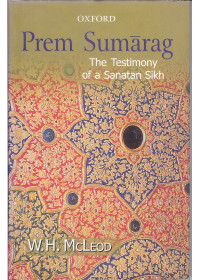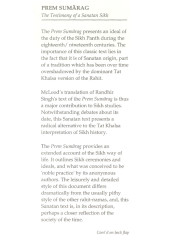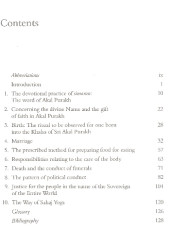Monday to Saturday - 10:00 Am to 9 PM
Now Enjoy Bulk Discounts on Books as Mentioned Below
These Discounts are in addition to the Discounts on Individual Books (Visible as Bulk Discount for Books in Cart)
Extra 10% Off If Books Purchased Exceeds Rs 3000 or 75 USD or 60 GBP or 60 Euro or 100 AUD or 100 CAD
Extra 15% Off If Books Purchased Exceeds Rs 6000 or 150 USD or 120 GBP or 120 Euro or 200 AUD or 200 CAD
Extra 20% Off If Books Purchased Exceeds Rs 15000 or 225 USD or 180 GBP or 180 Euro or 300 AUD or 300 CAD
Extra 25% Off If Books Purchased Exceeds Rs 30000 or 300 USD or 240 GBP or 240 Euro or 400 AUD or 400 CAD
Introduction To Book 'Prem Sumarag The Testimony of a Sanatan Sikh' By W. H. McLeod
This translation of Randhir Singh's text of Prem Sumarag ( or Param Sumarag ) is the third and last instalment of a research project, dealing with the history of the Khalsa Rahit, which began in 1978. A first instalment was The Chaupa Singh Rahit-nama, published in 1987 by the University of Otago Press in Dunedin. The second instalment (the chief contribution) was Sikhs of the Khalsa: A history of the Khalsa Rahit, published by the Oxford University Press of New Delhi in 2003. With the Prem Sumarag, this enterprise reaches its conclusion.
A Sanatan document
The importance of Prem Sumarag lies in the fact that it is a Sanatan product, very different from the Tat Khalsa versions which, during the twentieth century, came increasingly to dominate the Rahit debate and which eventually issued in the Sikh Rahit Marayada of 1950. The overwhelming dominance of the Tat Khals version of the Rahit evidently succeeded in having Prem Sumarag buried and forgotten, and with it other works of
The most important work dealing with the subject is Harjot Oberoi, The Construction of Religious Boundaries: Culture, identity and diversity in the Sikh Tradition (Delhi: 1994, and Chicago: 1994). See also W.H. McLeod, Sikhs of the Khalsa: A history of the Khalsa Rahit (New Delhi: 2003), pp.158-65. a Santan persuasion. It is thanks to the work of Randhir Singh that it has been exhumed, and this translation will endeavour to make it better known amongst scholars and others who are interested in Sikh history. These include scholars who read Punjabi as well as those who know only English. The language of Prem Sumarag is not always clear, and the task of translating the work sometimes presented difficulties, particularly in the case of the eighth and ninth chapters.
The Prem Sumarag, however, is not without its problems, and of these an important one is its date. Is it an eighteenth-century work and, if so, was it written during the early part of the century? Alternatively, does it belong to the latterpart of the eighteenth century? Or should it not be placed in the first half of the nineteenth century? There are also those who would have it positioned during the early British period, in other words during the latter half of the nineteenth century, prior to the emergence of the massively important Singh Sabha reform movement.
Prem Sumarag offers an extended Sanatan account of Sikh ceremonies and the Sikh way of life, and if it is to be placed in the eighteenth century, the account which it gives is an early one. In this respect, as we have already noted, it differs radically from the Tat Khalsa interpretation that was later to overwhelm it. Tat Khalsa concepts have buried Sanatan alternatives so effectively that it can now be very difficult to think in terms other than the Tat Khalsa's. This work provides, by way of contrast, a distinctive Sanatan pattern, different from that of the Tat Khalsa. This pattern was to continue over several generations, and although it has long been rendered invisible, it is still maintained by a minority of Sikhs of the Khatri and Arora castes.
Prem Sumarag provides a detailed account of Sikh ideals and what was conceived to be noble practice by the anonymous person or persons who wrote it. It may, ofcourse, represent an eccentric view, though this appears to be unlikely. Jats may have had relatively little time for it, but Jats did not control all Sikh statements. Although the strongly Sanatan period follows the first recording of the Prem Sumarag, Sanatan views were certainly present during the eighteenth century. They, were however, more likely to be expressed by the members of the Khatri caste, and references in the text suggest that this particular work was indeed written by a Khatri. During the time of Maharaja Ranjit Singh,
This means that it was the work of a person of a highly-ranked caste and represents an elite view of the Khalsa. It does not represent popular religion with its devotion to pilgrimage, sacred places, idols, celebrated saints, and belief in miracles. Chapter 4
Sanatan beliefs secured an increasing hold amongst literate Sikhs, and the fact that was extensively quoted by the Englishman Major R. Leech in his 1844 report supports the view that it was widely accepted by the Panth in general during the middle period of the nineteenth century.
The style of Prem Sumarag differs dramatically from that of the other rahit-namat. With only one other exception all of the rahit-namas that date from the eighteenth or nineteenth centuries are brief and crisp. Prem Sumarag is, by contrast, frequently detailed in content and always leisurely in style. This is particularly the case in its instructions concerning the various types of marriage that may be performed within the Panth, instructions which contrast stongly with the brevity of its account of the method of initiation. The other exception that describes the Rahit at length is the one attributed to chaupa Singh, which dates from the middle years of the eighteenth century. In terms of length Prem Sumarag certainly resembles it, but there the likeness ceases. Only in its two narrative portions does the Chaupa Singh Rahit-nama adopt a style that can be compared to that of Prem Sumarag. Occasionally, the parallels are actually quite close, even to the point of suggesting that certain passages accessible to the Chaupa Singh Rahit nama. In general, however, the style of the two rahit-namas differs considerably, particularly in the two Chaupa Singh sections devoted to enunciating the Rahit.
The content and tone of Prem Sumarag are clearly aligned with the Sanatan interpretation, with the inevitable result that it met with distinctly guarded reception from Kahn Singh Nabha and other members of the Tat Khalsa segment of the Singh Sabha. Randhir Singh has endeavoured to establish the early provenance of the work, arguing vigorously in favour of a clear link with the intention of Guru Gobind Singh ,following the establishment of the Khalsa at the end of the seventeenth century. Was he justified in fixing the date so insistently?
Randhir Singh has certainly had his supporters. Four of these stand out, the first being Mohan Singh. In a chapter of his An Introduction to Punjabi Literatur entitled 'The Age of Prem Sumarag (AD 1708 to 1780)'
that it should be located in the early nineteenth century. Those favouring this view were much less numerous than those supporting an eighteenth century interpretation, but they included two very impressive figures, namely Kahn Singh Nabha and Principle Teja Singh. Then there are those who maintain that Prem Sumarag dates from the British period, which began in 1849. These are Surjit Hans and his student Gurpreet Kaur.
Jagtar Singh Grewal provides an interesting case-interesting because he has twice changed his opinion concerning the dating of Prem Sumarag. Grewal at first concluded in an essay published in 1972 that the work belonged to the early eighteenth century. In the 1982 edition of From Guru Nanak to Maharaja Ranjit Singh, he retracted this opinion, accepting instead the view that it was composed during 'the first quarter of British rule in the Punjab, viz after 1849. This was 'in deference to the argument of Dr S.S. Hans that was a late nineteenth-century product. In an article entitled 'Definition: Sikh', published in The Times of India on28 April 1991, he maintained this view. Since then, however, he has reverted to his original position. In 1996 a revised version of his original essay appeared in his Sikh Ideology, Polity and Social Order.
The Situation is actually more complicated than the Published works indicate. In 1978, Professor Grewal expressed, in conversation with me, his view that Prem Sumarag probably dates from the early eighteenth century and that is certainly pre-dates the time of Maharaja Ranjit Singh. There are, he claimed, several reasons for holding this view, of which he mentioned two. The first is that the text claims that a Sikh when attacked by a Muslim should insult the Muslim's Prophet and fight back. The second is that administrative detail is definitely Mughal and equally definitely not that of Ranjit Singh.
Table Of Contents Of The Book 'Prem Sumarag The Testimony of a Sanatan Sikh' By W. H. McLeod
|
CONTENTS |
||
| Abbreviations | ix | |
| Introducing | 1 | |
| 1. | The devotional practice of simaran: | 10 |
| The word of Akal Purakh | ||
| 2. | Concerning the divine Name and the gift of faith in Akal Purakh | 22 |
| 3. | Birth: The ritual to be observed for one born into the | 28 |
| Khalsa of Sri Akal Purakh | ||
| 4. | Marriage | 32 |
| 5. | The prescribed method for preparing food for eating | 57 |
| 6. | Responsibilities relating to the care of the body | 63 |
| 7. | Death and the conduct of funerals | 71 |
| 8. | The pattern of political conduct | 82 |
| 9. | Justice for the people in the name of the Sovereign | 104 |
| of the Entire World | ||
| 10. | The Way of Sahaj Yoga | 120 |
| Glossary | 126 | |
| Bibliography | 128 |
Prem Sumarag The Testimony of a Sanatan Sikh - Book By W. H. McLeod
- Brand: Oxford University Press
- Product Code: SPE204
- Availability: Out Of Stock
-
Rs.450.00
Related Products
Sikhs in The Eighteenth Century - Book By Surjit Singh Gandhi
Table of Contents For 'Sikhs in The Eighteenth Century' - Book By Surjit Singh Gandhi ..
Rs.500.00
Martyrdom In The Sikh Tradition - Playing The Game Of Love - Book By Louis E. Fenech
Introduction To 'Martyrdom In The Sikh Tradition, Playing The Game Of Love' By Louis E. Fenech Th..
Rs.325.00
Prem Sumarag Granth - Book By Randhir Singh
Prem Sumarag Granth -Book By Randhir Singh ( History Research Scholar ) ..
Rs.150.00
Exploring Sikhism - Aspects Of Sikh Identity, Culture, And Thought - Book By W.H.Mcleod
Introduction To 'Exploring Sikhism , Aspects Of Sikh Identity, Culture, And Thought' By W.H.Mcleo..
Rs.250.00
Sikh Ethos - Eighteenth Century Perspective - Book By Jaspreet Kaur Sandhu
From The Backcover Of 'Sikh Ethos - Eighteenth Century Perspective' By Jaspreet Kaur Sandhu ..
Rs.175.00
Return To Empire - Punjab Under The Sikhs And British In The Mid-Nineteenth Century - Book By Andrew J Major
From The Frontcover Of 'Return To Empire - Punjab Under The Sikhs And British In The Mid-Nineteen..
Rs.400.00
Tags: book by w. h. mcleod, prem sumarag the testimony of a sanatan, sikh, philosophy, books, english










